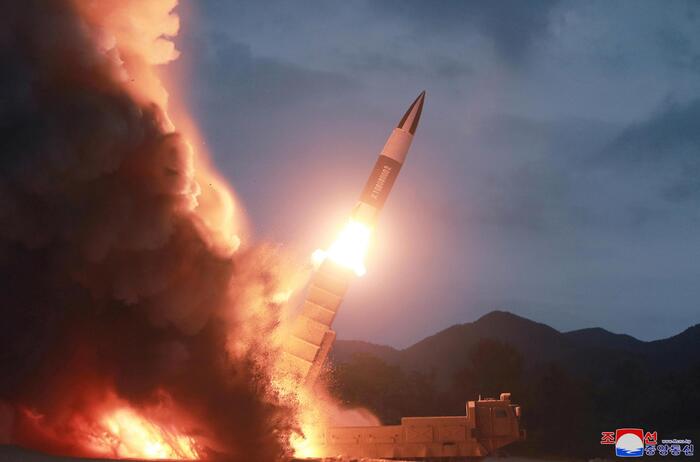Enlarge image
Global threat: Image shared by North Korea's state-run news agency of Thursday's launch of the Hwasong-17 missile
Photo: KCNA/KNS/AP
On Thursday, the North Korean military fired a new long-range missile called the Hwasong-17 in a test.
President Kim Jong Un said this was to demonstrate the power of his nuclear force and deter the US from any military move against North Korea.
It was the first major test of an ICBM since 2017. There were two launches in February that US officials say were preliminary exercises by the Hwasong-17.
According to experts, the resumption of the tests now brings the state closer to the goal of being able to attack any location in the USA with several nuclear warheads.
With a range of likely more than 15,000 kilometers, according to the Japanese government, the North Korean missile could theoretically reach land targets anywhere on Earth except for a few countries in South America and parts of Antarctica.
Multiple warheads to confuse defenses
That range and the massive size of the missiles suggest North Korea is working on techniques that would allow it to be armed with multiple nuclear warheads, according to experts polled by Reuters.
These could hit multiple targets at the same time or represent decoys to confuse the air defense.
The smaller, long-range Hwasong-15 missile, tested in 2017, could arguably hit any target in the US in terms of range, but not carry such a heavy load.
"Since there are few good targets further away, the point of this missile is probably to carry more weight -- in the form of multiple nuclear warheads," said researcher Melissa Hanham of the Center for International Security and Cooperation at Stanford University, California.
"This makes it even harder to secure US missile defenses," Hanham told Reuters.
Among other new weapons such as hypersonic weapons, small nuclear warheads and drones, North Korea's leader Kim Jong Un has announced the targeting of 15,000-kilometer long-range missiles with multiple nuclear warheads.
"The arithmetic of the offensive will soon be working in the North Koreans' favor," said Ankit Panda of the Carnegie Endowment for International Peace.
"They will probably be able to keep up with the advances in American intelligence."
US government officials have already warned of such developments.
Last year, defense contractors Lockheed Martin and Northrop Grumman were chosen to compete for a Next Generation Interceptor (NGI) defense system.
Thomas Karako, head of the Missile Defense Project at the Center for Strategic and International Studies (CSIS), said this should be able to shoot down projectiles from so-called “rogue states” such as North Korea or Iran.
"This gives North Korea more options," he said of Hwasong-17.
The longer range could allow the state to target the United States via indirect flight routes and thus possibly confuse the defense.
A minimum of credible deterrence
Newly elected South Korean President Yoon Suk-yeol has announced plans to step up missile defenses against the North's weapons.
According to him, developing a first strike capability is probably the only way to prevent a missile attack.
North Korea's "elevated" missile tests, which launch the missiles high into space rather than far above the ground, reveal some elements of the system, such as the thrust of the rocket engines or the placement of the rocket stages.
Other aspects were harder to check in such tests, said Joseph Dempsey, a military researcher at the International Institute for Strategic Studies.
As examples he cited the accuracy or the durability of the missile parts that would carry warheads to the target after re-entering the atmosphere.
"Typically, before a system is accepted, mass-produced, and put into service, you do dozens of tests of varying degrees across a full spectrum of operating characteristics," he said.
North Korea is diplomatically and geographically limited in its ability to conduct long-distance tests.
"But even limited, successful testing can provide a bare minimum of credible deterrence."
Fired vertically
Thus, the elevated tests expose the reentry stages to much greater heat and stress than a normal trajectory for a real attack.
This means that they intentionally perform worse and work less well than planned.
North Korea said the missile was fired "in vertical mode" on Thursday to ensure the safety of neighboring countries.
Rachel Minyoung Lee of Washington's 38 North Programme, which monitors North Korea, said Pyongyang's goal seems to be to build more pressure potential.
International talks on the country's nuclear disarmament could then be turned into talks on merely dismantling the nuclear force.
"The message of North Korea's statement on yesterday's long-range test is clear: North Korea will continue to develop its nuclear arsenal," she said.
Premiere for rocket launch trucks
Thursday's launch revealed for the first time that the Hwasong-17 was fired from a large 11-axle transport, lift and launch vehicle.
Previous North Korean long-range missiles used such vehicles to deliver and lift to the launch site, but then launched from separate platforms.
The trucks make it easier to hide the missiles until ready for launch.
However, Ankit Panda said the Hwasong-17 is so large that the practical utility of this system is seriously questioned.
"There's a reason no other country has ever decided to deploy such a large liquid-fueled rocket on a roadworthy mobile launch pad," Panda said.
"It is unsafe and impractical for use." But North Korea seems to accept the risk.
"A silo that would make more sense for a missile that size would be strategically worse for the North Koreans because it's vulnerable to pre-emptive attacks."
The next step for North Korea is to develop solid-propellant missiles.
These would be more stable and could be fired with almost no warning or preparation time.
ak/Reuters






